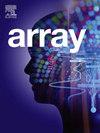Cobb angle prediction for adolescent idiopathic scoliosis via an explainable machine learning model
IF 4.5
Q2 COMPUTER SCIENCE, THEORY & METHODS
引用次数: 0
Abstract
This study aims to build an accurate and interpretable machine learning model capable of adolescent idiopathic scoliosis prognostication. A tree-based gradient boosting machine is incorporated with a recently proposed Shapley-value-based explanation method-TreeExplainer. Anthropometric training data are collected from a public orthopedics clinic, and each instance is characterized by nine features with a prediction target. We adopt a transfer-learning strategy that takes advantage of the additive property of tree-based gradient boosting, allowing a gradient boosting machine regressor to be trained with limited labeled examples. Cross-validation estimation shows a satisfactory performance for predicting future spine curvature (Cobb angle). The root mean square error (), the mean absolute percentage error (), and the Pearson correlation coefficient are 3.69 ± 1.23, 2.81 ± 1.69, and 0.92 ± 0.01, respectively. Moreover, the overfitting has been largely removed, and the model may be generalized well to new patients. A well-trained model is taken as the input to the TreeExplainer. The output of the TreeExplainer provides us a richer understanding that demonstrates how a feature’s value impacts the model’s prediction for every instance. The patterns identified can substantially improve the human-artificial intelligence collaboration in the clinical management of patients with adolescent idiopathic scoliosis by preventing serious scoliosis progression and reducing healthcare costs.

通过可解释的机器学习模型预测青少年特发性脊柱侧凸的Cobb角
本研究旨在建立一个准确且可解释的机器学习模型,用于青少年特发性脊柱侧凸的预测。将基于树的梯度增强机与最近提出的基于shapley值的解释方法treeexplainer相结合。人体测量训练数据收集自一家公共骨科诊所,每个实例具有9个特征和预测目标。我们采用了一种迁移学习策略,该策略利用了基于树的梯度增强的可加性,允许梯度增强机器回归器用有限的标记示例进行训练。交叉验证估计在预测未来脊柱曲度(Cobb角)方面表现令人满意。均方根误差(°)、平均绝对百分比误差(°)和Pearson相关系数分别为3.69±1.23、2.81±1.69和0.92±0.01。此外,过度拟合在很大程度上被去除,模型可以很好地推广到新患者。一个训练有素的模型被作为TreeExplainer的输入。TreeExplainer的输出为我们提供了更丰富的理解,演示了特征值如何影响模型对每个实例的预测。所确定的模式可以通过预防严重的脊柱侧凸进展和降低医疗成本,大大改善青少年特发性脊柱侧凸患者临床管理中的人类-人工智能协作。
本文章由计算机程序翻译,如有差异,请以英文原文为准。
求助全文
约1分钟内获得全文
求助全文

 求助内容:
求助内容: 应助结果提醒方式:
应助结果提醒方式:


